I have covered developments in the field of extrasolar planets since 1995, when the first planet around a Sun-like star was announced around 51 Pegasi. With the pace of discovery advancing at a seeming exponential rate (the current tally is 525 and rising fast), I feel a bit jaded whenever a new exoplanet result is announced. It takes a lot to impress me.
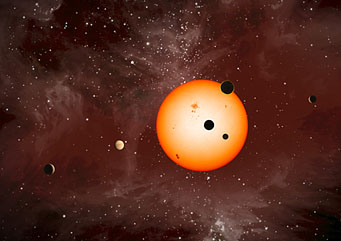
An artistic rendition of the 6 known planets orbiting Kepler-11. On August 26, 2010, NASA's Kepler observatory recorded three of them crossing the star's disk at once.
JPL / IPAC
Consider me impressed. In what astrophysicist Jack Lissauer (NASA/Ames Research Center) calls "the most important exoplanet discovery since 51 Peg," scientists on the team for NASA’s Kepler space telescope have announced an entirely new planetary system that seems so outrageous I almost don’t want to believe it.
The system consists of at least six planets, all of which orbit the host star in such perfect alignment to one another and to our line of sight that they periodically cross the face of the star’s disk, an event known as a transit. Not only that, five of the six are packed so closely near the star that they would easily fit inside Mercury’s orbit if they were going around the Sun. Their orbital periods range from 10.3 to 46.7 days.
If that isn't impressive enough, the planets themselves are unlike anything in our solar system. The five innermost planets range in mass from about 2.3 to 13.5 times that of Earth, and vary in diameter from about 2 to 4.5 times that of Earth. Being so close to the host star's heat and wind, one might expect them to be scaled-up versions of the terrestrial planets, like the recently discovered "cannonball planet" Kepler-10b. But the five worlds have surprisingly low densities, ranging from 3.1 grams per cubic centimeter at the high end (slightly less dense than our Moon) to only 0.5 g/cm3 (less dense than Saturn, which consists almost entirely of gas).
As Lissauer points out, the planets are more like mini-Neptunes than super-Earths. They probably have rock-iron cores that are surrounded by thick envelopes of ice and gas. Adds team member Jonathan Fortney (University of California, Santa Cruz), "I think of them as being like a marshmallow with a ball bearing in the center. Most of the mass is in the core, but most of the volume is in the atmosphere."
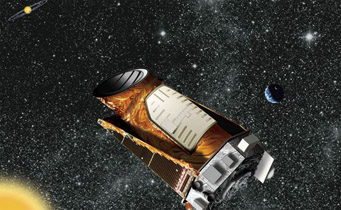
NASA's Kepler Space Telescope.
NASA/Kepler mission/Wendy Stenzel
Kepler scientists led by Lissauer discovered the planets by seeing how much each one slightly dims the host star’s light every time it transits. The amount of dimming reveals the planet’s diameter. Normally, astronomers follow up Kepler planet candidates by looking for subtle changes in the star’s spectrum as it wobbles under the gravitational influence of one or more planets. These radial-velocity measurements can confirm a planet’s existence and reveal its mass.
But in the case of Kepler-11, the star is so faint (magnitude 14) that performing these measurements will be extremely challenging. Instead, Lissauer and his colleagues have measured the mass of the five innermost planets by seeing how they gravitationally jostle one another, perturbations that show up as subtle variations in the transit timings.
Unfortunately, the sixth planet, which orbits considerably farther out (a little beyond where Mercury orbits the Sun, and with a period of 118 days), hasn’t affected the inner planets enough yet for its mass to be measured. The planet is about 3.7 times the diameter of Earth, but all the Kepler team can say about its mass is that it’s less than 300 Earths (a little less than a Jupiter mass) — otherwise they'd have detected its gravitational influence by now.
Nobody was predicting that Kepler would discover such a system, or even that such a system might actually exist in nature. As exoplanet researcher David Charbonneau (Harvard-Smithsonian Center for Astrophysics) notes, "It's quite simply one of the most beautiful data sets I have ever seen! I knew it was possible in principle to find a system of six transiting planets, but when it materialized I could barely believe it."
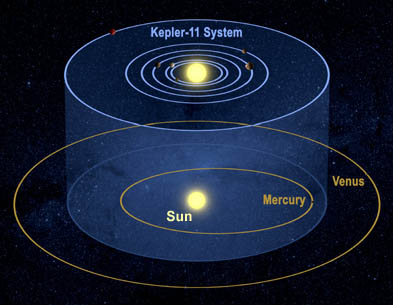
The six-planet system surrounding the star designated Kepler-11 would fit entirely inside the orbit of Venus.
NASA / Kepler Science Team
Computer simulations of the system’s long-term evolution show that the configuration is gravitationally stable for the 8-billion-year estimated lifetime of the host star. The star itself is very similar to the Sun in mass and temperature, but is older and slightly puffed up. It’s about 2,000 light-years from Earth in the constellation Cygnus.
The planets appear to trace nearly circular orbits, and their orbital planes are aligned to within 1° or 2° — prerequisites for maintaining long-term stability. Surprisingly, none of the planets are locked in orbital resonances with their siblings, meaning their orbital periods don’t come in ratios of simple integers.
All of these factors indicate that the planets formed farther out than their current orbits, and slowly and gently migrated inward within a gas-rich disk that possibly contained huge numbers of asteroids. The gravitational influence of gas and small bodies would tend to circularize the orbits and keep their orbital planes well aligned, and would help prevent the planets from locking one another into resonances.
The planets generally become less dense the farther they orbit the parent star, a relationship that hardly comes as a surprise. The host star’s heat and wind is blasting the planets, a violent interaction that is slowly stripping away their atmospheres, with the innermost planets suffering the most. "This is exactly the kind of system you want in order to study this mass-loss process," says Fortney. "Six planets around the same star; it’s ideal for comparative planetary science."
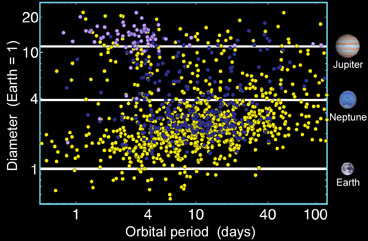
As of February 1, 2011, NASA's Kepler spacecraft had identified 1,235 candidates (yellow and dark-blue dots), far more than the count of transiting exoplanets known prior to the mission (violet dots). Click on the image for a larger version.
NASA / Wendy Stenzel
Lissauer also points out that there could be additional undetected planets, either inside the innermost planet, between the fifth and sixth planets, or outside the known planets. If the planet is massive enough, it should eventually reveal itself through its gravitational perturbations of the known worlds.
Exo-Earths Galore
If the new multiplanet system doesn’t yet impress you, take note that Kepler scientists today also announced hundreds of new exoplanet candidates, bringing the mission's total to 1,235. Of the newly-announced candidates, dozens are Earth-diameter or smaller. Team member Geoff Marcy (University of California, Berkeley), who has been involved in more planet discoveries than anyone in history, estimates that "90% to 95% of these candidates are bona fide planets." Adds team member Daniel Fabrycky (University of California, Santa Cruz), "There are a ton of multiple-planet candidates from Kepler. There are 115 doubles, 45 triples, 8 quadruples, 1 quintuple, and 1 sextet (Kepler-11). So Kepler-11 is just the extreme end of a distribution, not a freak."
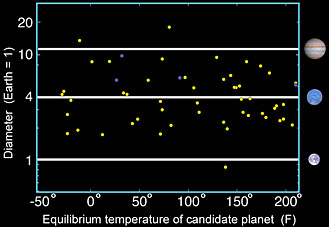
As of February 2011, NASA's Kepler spacecraft had identified 54 planet candidates in the "habitable" temperature zones of their host stars.
NASA / Wendy Stenzel
Of Kepler’s 1,235 planet candidates, 68 are about the size of Earth. Five of those orbit within the habitable zone of the host star — the region around a star where water on a planet's surface can exist in a liquid state. Overall, 54 of the new planet candidates orbit within their star’s habitable zone, 49 of which range from about twice Earth’s diameter to larger than Jupiter.
All of this suggests that Kepler's most exciting results lie in the future. And who knows, after the exoplanet count has risen into the thousands, and astronomers have characterized individual planets and systems to the point where they truly understand the full diversity of what’s out there, maybe it will turn out that our solar system is the freak.
Here's more from NASA on the six-planet system and on Kepler's overall new data release.

New worlds to gain. Dan Durda, a planetary scientist specializing in asteroids, creates planetary space art in his spare time. This work, titled "Cabbage Melons of HD147513b," suggests one of endless possibilities for Kepler's new exoEarth candidates that orbit in their stars' habitable zones.
See a larger version, and Durda's other works. He captions this one: "Log Entry 47. 24 November 2236. After 15 days we finally reached the northern edge of the great desert. Tomorrow we should reach the foothills we've seen on the horizon for the last two days. This afternoon Collins found a patch of succulent plants that should help with our dwindling water supply. He first referred to them as 'cabbage melons', so the name has stuck...."
 12
12
Comments
Robert
February 3, 2011 at 6:20 am
"Of Kepler’s 1,235 planet candidates, 68 are about the size of Earth. Five of those orbit within the habitable zone of the host star "
AWESOME!!!
You must be logged in to post a comment.
Larry
February 3, 2011 at 8:38 am
It certainly points to a very very planet rich environment. Kepler is measuring about 100,000 stars in a very small star field constantly. Out of these stars, most don't have a planetary system that will carry planets between the star and the telescope, which must be within 1 or 2 degrees. You have to figure that leaves 98% of most planets undetectable orbiting their stars. Yet Kepler is still finding hundreds of planets (now after just 1 year, to 1235).
You must be logged in to post a comment.
Larry
February 3, 2011 at 8:38 am
It certainly points to a very very planet rich environment. Kepler is measuring about 100,000 stars in a very small star field constantly. Out of these stars, most don't have a planetary system that will carry planets between the star and the telescope, which must be within 1 or 2 degrees. You have to figure that leaves 98% of most planets undetectable orbiting their stars. Yet Kepler is still finding hundreds of planets (now after just 1 year, to 1235).
You must be logged in to post a comment.
Jeffrey Smith
February 3, 2011 at 5:51 pm
Unbeleivable!!!Like many, I've been waiting years for these results to be published. Even if the majority are not confirmed, for the first time we can plug some real numbers into the Drake equation for the first time. A congragulatory toast needs to go out to the mission, all the exoplannet scientists, mission, & JPL/NASA scientists. This is a day we should never forget.
You must be logged in to post a comment.
Basem F. Kandah
February 4, 2011 at 11:14 am
The Human race has been waiting a few years to hear about these planets. maybe in the next 50-100 years we will actually find an earth-like planet orbiting a sun-like star with something living on it. What a day that will be. Thank you Kepler and all the supporting cast that make this possible. bk
You must be logged in to post a comment.
Michael C. Emmert
February 4, 2011 at 6:18 pm
This is, after all, a triumph of observational astronomy...
I had placed a general bet on Mike Brown's site that Kepler would find 13 Earthlike planets (both mass and habitable zone, no "like as we don't know it", no Mono Lake arsenic creatures [all very interesting]). But that was an "official" bet, since AFAIK nobody had taken tha famous square yet.
The letter I posted said that that was an optimistic estimate; the estimate has gone both ways. There are a lot of stars being monitored; there's about a 1 1/2% chance of finding an Earth so that's about 500 planets if every star had one. Apparently about 1% of stars do. I looked at the then-known planets and noticed the tremendous destruction derby which seemed to be caused by excessive mass in the systems (I have modeled that).
It's good to know the real truth. 😀
You must be logged in to post a comment.
Robert Stinson
February 5, 2011 at 8:24 am
These discoveries are fantastic. But think of the possibilities for exploration and development.
Just think of taking a seat on your back porch after dinner and watch the twin moons in the sky along with an Andromeda type galaxy the size of the Big Dipper off to the north. Stunning, Mind boggling! A scientists' dream assignment to be on a planet such as that. But, after the first sign is put up announcing the 'Coming Soon' of a strip mall with a fast food joint well, there goes the neighborhood.
Robert
You must be logged in to post a comment.
Anders Rydberg
February 5, 2011 at 9:29 am
The text in figure 1 is not fully correct since it says “As of February 1, 2011, NASA's Kepler spacecraft had identified 1,235 candidates (yellow and dark-blue dots), …………”. February 1, 2011. It is not as of February 1, 2011 but data from May 12 to Sept. 17, 2009. Please observe what NASA says: “The findings are based on the results of observations conducted May 12 to Sept. 17, 2009, of more than 156,000 stars in Kepler's field of view, which covers approximately 1/400 of the sky. See: http://kepler.nasa.gov/news/nasakeplernews/index.cfm?FuseAction=ShowNews&NewsID=98
This makes the results even more interesting since the data comes only from the 4 first months of operation of the Kepler telescope.
You must be logged in to post a comment.
coolstar
February 9, 2011 at 10:14 am
One certainly can't argue that the diversity of planetary systems that Kepler is finding is incredible. I do find the data on earth-sized planets in the habitable zones of their planets rather depressing though. Only 10% of the planets found in habitable zones are earth sized. The portion of parameter space surveyed in this release is for relatively short period orbits, but those are also the easiest to find. It's doubtful that the number of habitable planets around K & M dwarfs will increase by, at most, a factor of two as the mission progresses. Since K & M dwarfs make up 70% or more of all stars in the galaxy,it's beginning to look as though potentially habitable "earths" are quite rare.
You must be logged in to post a comment.
Peter Wilson
February 9, 2011 at 4:26 pm
"...most don't have a planetary system that will carry planets between the star and the telescope, which must be within 1 or 2 degrees." Assuming alignment is random, what fraction of all stars can be expected to have planets, based on the data?
You must be logged in to post a comment.
Stefan W.
February 10, 2011 at 1:20 pm
To answer the 2 last comments, let's do some crude math:
* geometric probability to spot earth: 0.47% (chances are very big it will _not_ transit between us and it's parent star!) http://kepler.nasa.gov/Science/about/characteristicsOfTransits/
* part of sky observed: 1/400
* number of found "potential habitable earthlike planets": 5
* "observation radius" of Kepler: 2000+ lightyears
This makes for 5x400x212.77 = 425532 earthlikes within 2000 ly !!
You must be logged in to post a comment.
Rod
February 12, 2011 at 7:08 am
Many of the comments posted on this report to me look more like a faith based issue vs. empirical science. What we have are some 528 exoplanets reported and 34 super earths reported (mass <=10 earths). The average mass is 5.9 earths, average AU is 0.19 from host star and average host star mass is 0.68 solar. The idea that current observations support the view that the earth formed randomly via particle collisions allowing it to be habitable and life on earth evolved spontaneously from non-living matter to populate the earth today remains conjecture concerning origins.
You must be logged in to post a comment.
You must be logged in to post a comment.